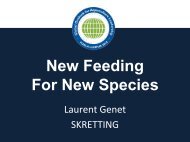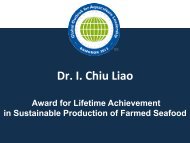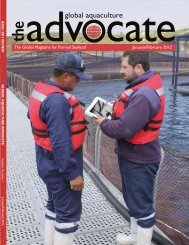May/June 2010 - Global Aquaculture Alliance
May/June 2010 - Global Aquaculture Alliance
May/June 2010 - Global Aquaculture Alliance
You also want an ePaper? Increase the reach of your titles
YUMPU automatically turns print PDFs into web optimized ePapers that Google loves.
Call us today to order the newly designed<br />
<strong>2010</strong> Master Catalog!<br />
Need an air diffuser? AES has a complete line of diffuser options,<br />
including Sweetwater ® and our own competitively priced brand.<br />
Let us help you make the right choice for your business:<br />
• Fish holding and hauling. • Ponds and lakes.<br />
• Pure gas. • Aquariums.<br />
• Hatcheries. • Wastewater.<br />
Visit us at <strong>Aquaculture</strong> America booths 102 & 104.<br />
2395 Apopka Blvd. Suite 100, Apopka, Florida 32703, USA<br />
Tel: +1 407 886 3939 Fax: +1 407 886 4884<br />
Web: www.AquaticEco.com<br />
Email: InternationalSales@AquaticEco.com<br />
Production of<br />
high-quality<br />
seedstock is one<br />
of the major<br />
health challenges<br />
faced by the<br />
tilapia industry<br />
worldwide.<br />
for all surfaces with direct or indirect contact with fish.<br />
Good sanitation can control or even eliminate disease outbreaks,<br />
but implementation can be a limiting factor. Employees<br />
must be proactive and experienced in applying well-defined protocols<br />
to meet clear goals. The aim is to ensure that fish welfare<br />
is the top priority, and any adverse event is reported and dealt<br />
with quickly.<br />
Record Keeping<br />
Another factor that correlates farm management to disease<br />
outbreaks is production recording. If recorded data is relevant,<br />
clear and precise, it can help in the early recognition of disease.<br />
Disease triggers are multifactorial and often complex, but timedata<br />
records enable comparisons of historical situations and often<br />
reveal repetitive disease trends.<br />
Typical patterns may include fluctuations in environmental<br />
parameters, changing characteristics in fish behavior and/or or<br />
the severity and onset of mortality within a population. Recognizing<br />
these triggers through good production records can go a<br />
long way in improving disease management.<br />
Culture Conditions<br />
The environment plays a crucial role in the expression of disease.<br />
For example, most diseases in tilapia thrive in certain temperature<br />
and salinity ranges. This adds to the complexity of tilapia<br />
farming, but such knowledge is a useful tool in disease<br />
control since, in many cases, temperature and salinity can be<br />
manipulated.<br />
Greenhouses, for example, are now common throughout<br />
aquaculture in China. They help prevent suboptimal growth and<br />
coldwater diseases. In addition, the use of saltwater, if readily<br />
available, can help control parasitic or saline-dependent bacterial<br />
outbreaks.<br />
Pathogens<br />
Tilapia are susceptible to both non-infectious and infectious<br />
diseases. An infectious disease occurs when a pathogen is present.<br />
While identifying the pathogen is a good start, that does not<br />
prove it is the cause of reduced performance, morbidity or mortality.<br />
To accurately diagnose the cause of disease, field sampling<br />
and diagnostic techniques must be performed.<br />
It is crucial that the correct samples are sent for analysis. Moribund<br />
fish should be sampled, since common environmental bacteria<br />
contaminate dead fish quickly and can mask identification of<br />
the pathogens that caused the disease. Furthermore, it is of no<br />
value to investigate fish with clinical signs that do not represent<br />
those of the greater diseased population.<br />
To really understand the cause of disease, it is essential to<br />
implement long-term, routine field sampling and disease epidemiology.<br />
Correct sampling techniques will identify the specific<br />
pathogens present and screen for anything new entering the sys-<br />
tem. Once established in the farm management system, this<br />
information, combined with knowledge about disease triggers,<br />
allows effective identification and resolution of problems.<br />
Major Bacterial Diseases<br />
For the last eight years, Intervet/Schering-Plough Animal<br />
Health has conducted extensive sampling and epidemiological<br />
investigations throughout Asia-Pacific, Africa and Latin<br />
America. Four major bacterial disease pathogens have been<br />
found – Streptococcus agalactiae, Streptococcus iniae, Flavobacterium<br />
columnare and RLO, which stands for rickettsia-like<br />
organism, recently identified as a species of Francisella. One<br />
viral disease, iridovirus, was identified, along with several<br />
important external protozoal and monogenetic parasites, such<br />
as the commonly foundTrichodina and Gyrodactylus species.<br />
Treatment And Prevention<br />
An integrated health management plan encompasses all<br />
factors that affect fish health. Key components of the plan are<br />
two complementary strategies aimed at dealing with infectious<br />
diseases. One is reactive pathogen exclusion, and the other is<br />
proactive pathogen prevention. Given time and understanding,<br />
the reactive strategy may develop into an optimized<br />
metaphilactic treatment given just before the fish get sick.<br />
Therapeutic medicines used in food animals, particularly<br />
antibiotics, have resulted in controversial discussions in the<br />
press recently. Environmentalists want assurances that natural<br />
ecosystems won’t be damaged, and consumers want to know<br />
that any antibiotic treatment used will not contribute to antibiotic<br />
resistance in people and that the foods they eat do not<br />
contain antibiotic residues. There has also been discussion<br />
about the presence of prohibited antibiotics in food animals.<br />
In light of these pressures and to ensure the sustainability<br />
of the aquaculture industry, it is imperative that reactive, therapeutic<br />
disease management be conducted responsibly. The<br />
first step is correct identification of the etiological disease<br />
agent and corresponding treatments. Treatment with an antibiotic<br />
may be indicated for an outbreak of bacterial infection,<br />
but cannot be used to treat parasites.<br />
Therapeutic drugs must be administered in strict compliance<br />
with manufacturers’ label recommendations regarding<br />
dose, duration and withdrawal times. Disease treatments<br />
should be supervised by fish health professionals to ensure that<br />
fish receive appropriate therapy, but it is fish farmers’ responsibility<br />
to adhere to specified withdrawal periods for antibiotics.<br />
It is also fundamental that any chemical administered has regulatory<br />
approval for use in fish in the local country.<br />
Perspectives<br />
History has taught us there will always be new diseases.<br />
But responsible therapeutic management can minimize the<br />
short-term impacts of disease and help allay fears among<br />
environmentalists and consumers. However, drug treatment<br />
should never be considered a long-term solution, since the<br />
root of disease problems must be identified and proactively<br />
addressed through integrated health management.<br />
Preventive disease strategies should aim at reducing stress<br />
in fish through good husbandry practices, the use of immunomodulators<br />
to boost the immune system and the use of<br />
vaccines. Remember that vaccines target specific diseases,<br />
and cross-protection rarely occurs.<br />
52 <strong>May</strong>/<strong>June</strong> <strong>2010</strong> global aquaculture advocate global aquaculture advocate <strong>May</strong>/<strong>June</strong> <strong>2010</strong> 53





